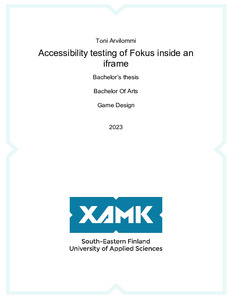Fokus-sovelluksen saavutettavuustestaus iframessa
Arvilommi, Toni (2023)
Arvilommi, Toni
2023
All rights reserved. This publication is copyrighted. You may download, display and print it for Your own personal use. Commercial use is prohibited.
Julkaisun pysyvä osoite on
https://urn.fi/URN:NBN:fi:amk-2023120835306
https://urn.fi/URN:NBN:fi:amk-2023120835306
Tiivistelmä
Accessibility has become an important part of developing web applications in the last few years, especially after laws considering accessibility were put into force in the EU and in Finland. All public sectors existing and new web services must comply with the laws, which enable equal access for everyone to respective services.
The goal of the thesis was to study and understand how testing an application that primarily works inside an iframe affects the accessibility testing process. Since iframe is not originally meant for full-scale applications, the hypothesis is that running an application inside an iframe may lead to additional accessibility concerns and require additional testing. Testing includes manual and automated testing methods and follows WCAG 2.1 guidelines provided by the Word Wide Web Consortium.
In the theory section, the study examines the legislation from different perspectives. Consequent sections focus on understanding what accessibility methods already exist and discuss what existing iframe accessibility considerations are available in official sources. The reader will also gain a general understanding of the WCAG 2.1 accessibility guidelines and which target groups are the primary targets for accessible features.
The case study section includes accessibility testing of the web application Fokus. Application is tested with manual and automatic testing methods and accessibility of screen readers is ensured. The tests mirror a checklist that covers all steps provided by the WCAG 2.1 guidelines. Once testing is finalized the results are analysed and accessibility problems that exist uniquely inside iframes are identified, and suggestions for future development cycles are developed.
The goal of the thesis was to study and understand how testing an application that primarily works inside an iframe affects the accessibility testing process. Since iframe is not originally meant for full-scale applications, the hypothesis is that running an application inside an iframe may lead to additional accessibility concerns and require additional testing. Testing includes manual and automated testing methods and follows WCAG 2.1 guidelines provided by the Word Wide Web Consortium.
In the theory section, the study examines the legislation from different perspectives. Consequent sections focus on understanding what accessibility methods already exist and discuss what existing iframe accessibility considerations are available in official sources. The reader will also gain a general understanding of the WCAG 2.1 accessibility guidelines and which target groups are the primary targets for accessible features.
The case study section includes accessibility testing of the web application Fokus. Application is tested with manual and automatic testing methods and accessibility of screen readers is ensured. The tests mirror a checklist that covers all steps provided by the WCAG 2.1 guidelines. Once testing is finalized the results are analysed and accessibility problems that exist uniquely inside iframes are identified, and suggestions for future development cycles are developed.
